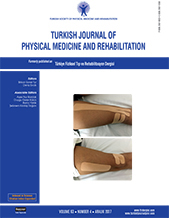Postural balance control in women with generalized joint laxity
2 Department of Anatomy, Medical Faculty of Adnan Menderes University, Aydın, Turkey
3 Department of Biostatistics, Medical Faculty of Adnan Menderes University, Aydın, Turkey
4 Department of Anatomy, Medical Faculty of Adnan Menderes University, Aydın, Turkey
5 Department of Physical Therapy and Rehabilitation, Medical Faculty of Adnan Menderes University, Aydın, Turkey DOI : 10.5606/tftrd.2017.160 Objectives: This study aims to investigate the potential relationship between joint laxity and postural balance by using tetra-ataxiometric posturography (Tetrax®).
Patients and methods: A total of 69 healthy volunteers were included in the study and classified into three groups based on their hypermobility severity determined with Beighton-Horan hypermobility index scores. Of those, 29 participants were non-hypermobile, 13 participants were mildly hypermobile and remaining 27 patients had severe hypermobility. Postural control of the participants was evaluated by using the Tetrax® device in eight different positions. The stability index, Fourier index, weight distribution index, and synchronization index scores of each participant were recorded.
Results: We found that the participants with severe hypermobility exhibited significantly higher stability index scores while the position of the head is extended and rotated right. The weight distribution index on elastic surfaces was impaired in non-hypermobile and severely hypermobile participants. We observed that the Fourier Index scores were higher at a higher-medium frequency (0.5-1 Hz) in participants with severe hypermobility. There was no difference between the groups in terms of synchronization index scores.
Conclusion: These findings suggest that severely hypermobile individuals have a decreased postural stability in head-extended and headrotated positions when compared to individuals who are non-hypermobile. This increased instability may lead to an increased risk of musculoskeletal injuries, especially in sports that require extension and rotation movements of the head.
Keywords : Balance control; hypermobility; posturography

















